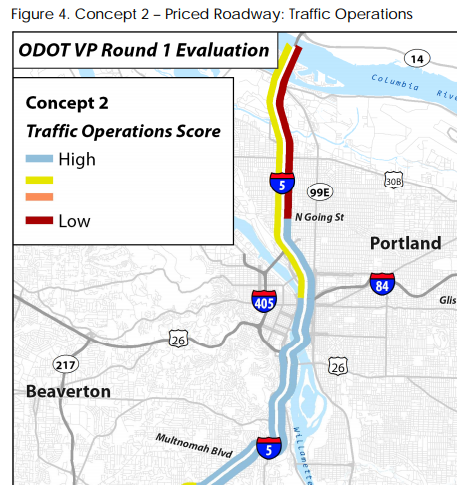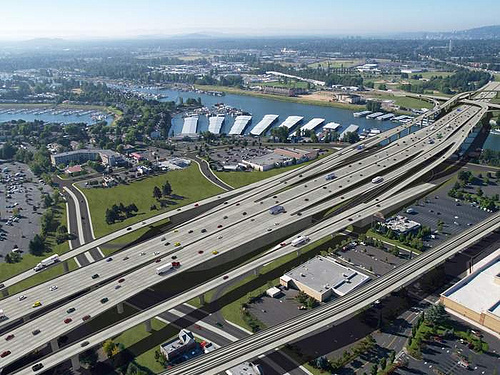What City Observatory did this week
A note to City Observatory readers: Bear with us, folks: We’re in the last week of our month-long deep dive into Portland’s debate about whether to spend a half billion dollars to widen a mile-long stretch of freeway near the city’s downtown. Based on all we’ve learned in our research at City Observatory, and our analysis of the project, we think its a signal example of the application of failed highway engineering practices that are likely to seriously damage a rebounding neighborhood in a thriving city. We think there are broad lessons for cities around the country, and so this week and next, we’ll be devoting most of our coverage to an in-depth examination of the project and its implications. Our regularly scheduled Week Observed features, “Must Read” and “New Knowledge” will return next week.
1. National Experts weigh in on Portland’s freeway-widening folly. The battle over whether Portland will squander half a billion dollars widening a mile-long stretch of Interstate 5 near the Rose Quarter has captured national attention. And the verdict of an impressive string of national experts is a mixture of shock and dismay: Janette Sadik-Khan says the project would turn the city from a progressive transportation king, to a jester. Robin Chase, founder of ZipCar added Portland’s planned investment in highway widening is pointless, counterproductive, and a misuse of funds. It’s a sign that Portland leader’s ought to pause and reflect on the direction this decision will take the city. There’s more a stake that just the Rose City’s progressive transportation reputation: this is really a battle to define the city’s values.
2. Congestion Pricing could solve Portland’s traffic problems faster, cheaper and better than freeway-widening. Oregon is on the path to deploy congestion pricing on its major north-south freeways I-5 and I-205. The Legislature directed implementation of pricing in a law passed in 2017; and the Oregon Department of Transportation has been studying it. But there’s one place you won’t find pricing: in the I-5 Rose Quarter’s Environmental Assessment. That’s tragic, because ODOT’s own studies show pricing would be unusually effective in reducing traffic congestion—and speeding transit and freight, and reducing emissions—and would do so at a cost far lower than expensive construction. The failure to advance pricing as an alternative in the EA is a blatant violation of NEPA’s requirement that the agency fully consider reasonable alternatives, and not discard alternatives without a careful and clearly identified reason.
3. Hiding a $3 billion freeway project. The marketing plan for the Rose Quarter Freeway widening project has been clear: paint it as a small scale, safety project. But dig deeper, and you’ll find there’s a $3 billion, 12-lane freeway project inextricably tied to the Rose Quarter: the Columbia River Crossing. Documents uncovered in response to a public records request show that the Oregon Department of Transportation assumed construction of the massive bridge in its “No-Build” traffic forecasting scenario: essentially funneling a firehose of imaginary traffic into the Rose Quarter project area, and creating a fictitious and exaggerated baseline level of traffic and congestion against which to measure its build alternative. Hiding these numbers, and concealing its assumption that the Columbia River Crossing was built (and in service in 2015), is a massive act of bad faith by the Department of Transportation, violating the spirit, and likely the letter of the National Environmental Policy Act. It also means that the estimates provided in the project’s EA present a contrived and biased picture of the project’s likely effects, rather than a fair and honest one. It’s no basis for reasoned public discussion and a prudent decision.
4. Lemming Models of Transportation. The heart of the case for the I-5 Rose Quarter Freeway widening project is based on traffic projections that purport to show that a wider freeway will have less congestion, less pollution and fewer carbon emissions than a no-build alternative. But it you look deep into the underlying assumptions of the models used to estimate future traffic levels, you’ll see that they make fundamentally unrealistic assumptions about travel behavior. In particular, the “static traffic assignment” used in four-step models allows forecasted traffic to exceed the actual capacity of roadways and intersections, and produces wild over-estimates of future traffic levels and congestion. In essence, the models treat traveler behavior like proverbial lemmings: drivers continue to pile into congested roadways, day after day and never change their behavior in the face of congestion. For the record, in real life not even lemmings do this; the myth of lemmings running over a cliff comes from a staged 1958 movie in which terrified lemmings were chased over the cliff. The errors in these models have long been understood by experts, but since the models neatly fit the biases of highway-building agencies, almost nothing has been done to fix them. In the case of the Rose Quarter project, the Oregon Department of Transportation’s lemming model overpredicts traffic in the base case, and therefore makes the $500 million widening look more effective than it would be in reality. It’s a flawed model that shouldn’t guide such an important decision.
In the News
1. Oregon Public Broadcasting‘s Jeff Mapes reported on our analysis that “ODOT used long dead I-5 bridge replacement to plan Rose Quarter.”
2. The Portland Business Journal (gated) published Joe Cortright’s Op-Ed estimating the extent of sales tax evasion in Vancouver Washington, and its impacts on traffic congestion in the Portland metropolitan area.





